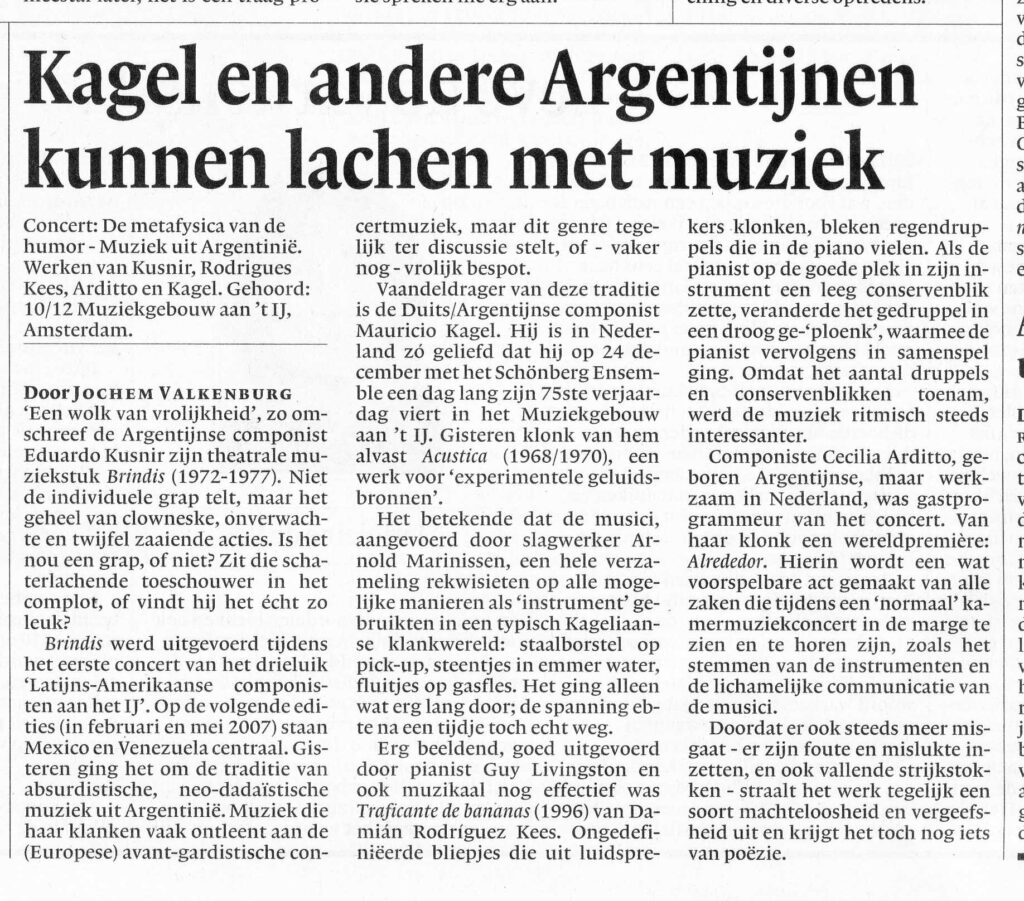Concert: De metafysica van de humor – Muziek uit Argentinië. Werken van Kusnir, Rodrigues Kees, Arditto en Kagel. Gehoord: 10/12 Muziekgebouw aan ’t IJ, Amsterdam.
‘Een wolk van vrolijkheid’, zo omschreef de Argentijnse componist Eduardo Kusnir zijn theatrale muziekstuk Brindis (1972-1977). Niet de individuele grap telt, maar het geheel van clowneske, onverwachte en twijfel zaaiende acties. Is het nou een grap, of niet? Zit die schaterlachende toeschouwer in het complot, of vindt hij het écht zo leuk?
Brindis werd uitgevoerd tijdens het eerste concert van het drieluik ‘Latijns-Amerikaanse componisten aan het IJ’. Op de volgende edities (in februari en mei 2007) staan Mexico en Venezuela centraal. Gisteren ging het om de traditie van absurdistische, neo-dadaïstische muziek uit Argentinië. Muziek die haar klanken vaak ontleent aan de (Europese) avant-gardistische concertmuziek, maar dit genre tegelijk ter discussie stelt, of – vaker nog – vrolijk bespot.
Vaandeldrager van deze traditie is de Duits/Argentijnse componist Mauricio Kagel. Hij is in Nederland zó geliefd dat hij op 24 december met het Schönberg Ensemble een dag lang zijn 75ste verjaardag viert in het Muziekgebouw aan ’t IJ. Gisteren klonk van hem alvast Acustica (1968/1970), een werk voor ‘experimentele geluidsbronnen’.
Het betekende dat de musici, aangevoerd door slagwerker Arnold Marinissen, een hele verzameling rekwisieten op alle mogelijke manieren als ‘instrument’ gebruikten in een typisch Kageliaanse klankwereld: staalborstel op pick-up, steentjes in emmer water, fluitjes op gasfles. Het ging alleen wat erg lang door; de spanning ebte na een tijdje toch echt weg.
Erg beeldend, goed uitgevoerd door pianist Guy Livingston en ook muzikaal nog effectief was Traficante de bananas (1996) van Damián Rodríguez Kees. Ongedefiniëerde bliepjes die uit luidsprekers klonken, bleken regendruppels die in de piano vielen. Als de pianist op de goede plek in zijn instrument een leeg conservenblik zette, veranderde het gedruppel in een droog ge-‘ploenk’, waarmee de pianist vervolgens in samenspel ging. Omdat het aantal druppels en conservenblikken toenam, werd de muziek ritmisch steeds interessanter.
Componiste Cecilia Arditto, geboren Argentijnse, maar werkzaam in Nederland, was gastprogrammeur van het concert. Van haar klonk een wereldpremière: Alrededor. Hierin wordt een wat voorspelbare act gemaakt van alle zaken die tijdens een ‘normaal’ kamermuziekconcert in de marge te zien en te horen zijn, zoals het stemmen van de instrumenten en de lichamelijke communicatie van de musici.
Doordat er ook steeds meer misgaat – er zijn foute en mislukte inzetten, en ook vallende strijkstokken – straalt het werk tegelijk een soort machteloosheid en vergeefsheid uit en krijgt het toch nog iets van poëzie.


